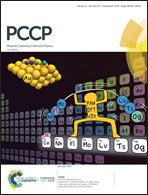The global motion affecting electron transfer in Plasmodium falciparum type II NADH dehydrogenases: a novel non-competitive mechanism for quinoline ketone derivative inhibitors†
Abstract
With the emergence of drug-resistant Plasmodium falciparum, the treatment of malaria has become a significant challenge; therefore, the development of antimalarial drugs acting on new targets is extremely urgent. In Plasmodium falciparum, type II nicotinamide adenine dinucleotide (NADH) dehydrogenase (NDH-2) is responsible for catalyzing the transfer of two electrons from NADH to flavin adenine dinucleotide (FAD), which in turn transfers the electrons to coenzyme Q (CoQ). As an entry enzyme for oxidative phosphorylation, NDH-2 has become one of the popular targets for the development of new antimalarial drugs. In this study, reliable motion trajectories of the NDH-2 complex with its co-factors (NADH and FAD) and inhibitor, RYL-552, were obtained by comparative molecular dynamics simulations. The influence of cofactor binding on the global motion of NDH-2 was explored through conformational clustering, principal component analysis and free energy landscape. The molecular interactions of NDH-2 before and after its binding with the inhibitor RYL-552 were analyzed, and the key residues and important hydrogen bonds were also determined. The results show that the association of RYL-552 results in the weakening of intramolecular hydrogen bonds and large allosterism of NDH-2. There was a significant positive correlation between the angular change of the key pocket residues in the NADH–FAD-pockets that represents the global functional motion and the change in distance between NADH-C4 and FAD-N5 that represents the electron transfer efficiency. Finally, the possible non-competitive inhibitory mechanism of RYL-552 was proposed. Specifically, the association of inhibitors with NDH-2 significantly affects the global motion mode of NDH-2, leading to widening of the distance between NADH and FAD through cooperative motion induction; this reduces the electron transfer efficiency of the mitochondrial respiratory chain. The simulation results provide useful theoretical guidance for subsequent antimalarial drug design based on the NDH-2 structure and the respiratory chain electron transfer mechanism.

- This article is part of the themed collection: 2019 PCCP HOT Articles


 Please wait while we load your content...
Please wait while we load your content...